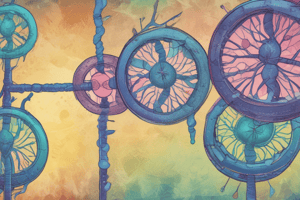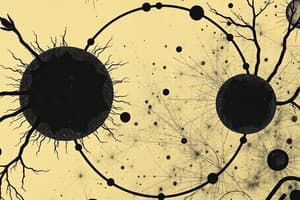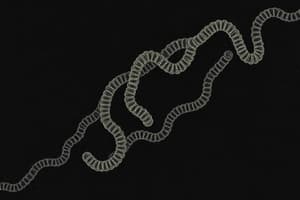Podcast
Questions and Answers
What is the relaxed form of DNA called?
What is the relaxed form of DNA called?
- Chromatin (correct)
- Histone
- Nucleosome
- Chromosome
What is the primary function of the plasma membrane in relation to cell size?
What is the primary function of the plasma membrane in relation to cell size?
- It regulates the passage of nutrients and waste. (correct)
- It stores genetic information.
- It provides structural support.
- It produces energy for the cell.
Why does the ratio of surface area to volume decrease as a cell gets bigger?
Why does the ratio of surface area to volume decrease as a cell gets bigger?
- The cell membrane becomes thinner.
- The surface area increases at a faster rate than the volume.
- The cell wall becomes thicker.
- The volume increases at a faster rate than the surface area. (correct)
What is one reason why diffusion becomes inefficient for larger cells?
What is one reason why diffusion becomes inefficient for larger cells?
What is a nucleosome composed of?
What is a nucleosome composed of?
What is the primary function of the cell cycle?
What is the primary function of the cell cycle?
Which of the following phrases best describes the process of cell division?
Which of the following phrases best describes the process of cell division?
What is the role of chromatin in cell division?
What is the role of chromatin in cell division?
Flashcards
Cell Cycle
Cell Cycle
The series of stages that cells go through to grow and divide.
Chromatin
Chromatin
The relaxed form of DNA found in the nucleus of a cell.
Chromosome
Chromosome
Condensed structures of DNA visible during mitosis.
Surface Area to Volume Ratio
Surface Area to Volume Ratio
Signup and view all the flashcards
Nucleosome
Nucleosome
Signup and view all the flashcards
Transport of Substances
Transport of Substances
Signup and view all the flashcards
Apoptosis
Apoptosis
Signup and view all the flashcards
Cancer
Cancer
Signup and view all the flashcards
Study Notes
Cellular Reproduction
- Cellular reproduction is the process by which cells grow and divide.
- A life cycle is a sequence of growth and development stages an organism goes through in its lifetime.
Cell Size Limitations
- Cell size is influenced by several factors.
- Surface area is the area covered by the plasma membrane. The plasma membrane is where nutrients enter and waste products leave the cell.
- Volume is the space taken up by the inner contents of the cell.
- As a cell gets larger, the ratio of surface area to volume decreases.
- Cells with a higher surface area-to-volume ratio can sustain themselves more easily. This is because nutrients can easily reach the organelles and waste products can easily exit the cell
- The need to keep a high surface area-to-volume ratio limits cell size.
Cell Size Measurement
- 1 meter (m) is equal to 10 decimeters (dm), 100 centimeters (cm), 1,000 millimeters (mm), 1,000,000 micrometers (µm), 1,000,000,000 nanometers (nm), and 1,000,000,000,000 picometers (pm).
- 1 mm is equal to 1000 microns.
- 1 inch is equal to 25400 microns.
Chromosomes
- Chromatin is the relaxed form of DNA.
- Chromosomes are condensed structures that contain DNA. They are visible during mitosis.
- Chromosomes are passed from generation to generation.
- Eukaryotic DNA is organized into chromosomes.
- Phosphate groups in DNA create a negative charge, attracting positively charged histone proteins and creating nucleosomes.
- Nucleosomes group together to form chromatin fibers, which supercoil to make up chromosomes.
The Cell Cycle
- Cells reproduce through a cycle of growth and division, called the cell cycle.
- Interphase is the stage where the cell grows, develops into a mature, functional cell, duplicates DNA, and prepares for division.
- Interphase is divided into three stages: Gap 1 (G₁), Synthesis (S), and Gap 2 (G₂).
- Gap 1 (G₁): cells grow, carrying out normal cellular functions, and preparing to replicate DNA.
- Synthesis (S): Copying DNA to prepare for cell division.
- Gap 2 (G₂): Preparing for the division of the nucleus.
- Mitosis is the stage of the cell cycle where the nucleus and nuclear material divide. It separates the replicated genetic material and prepares to split the cell into two.
- In multicellular organisms, mitosis increases the number of cells in young, growing organisms and helps organisms replace damaged cells.
- Mitosis helps maintain chromosome numbers in organisms that reproduce asexually.
Studying That Suits You
Use AI to generate personalized quizzes and flashcards to suit your learning preferences.




